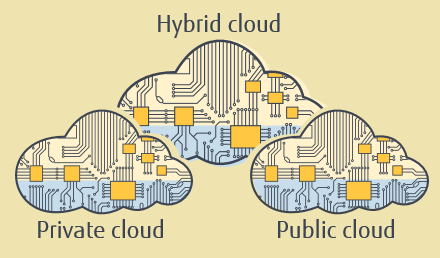 Key areas of concern have been in relation to the security and maturity of the hybrid cloud and the strong regulatory framework that the industry needs to comply with.
Key areas of concern have been in relation to the security and maturity of the hybrid cloud and the strong regulatory framework that the industry needs to comply with.
The Financial Services Industry (FSI) has been on the cloud journey for 10+ years and the adoption of the public cloud has rapidly accelerated in the last 3-5 years. The initial reluctance was no longer sustainable owing to the need to innovate, have a scalable cost/usage model, increase operational efficiency, and rapid global deployment of new products and services.
 The cloud journey for the industry was originally driven by increasing business needs of getting rid of large fixed cost structures and having faster deployment for new products and services. Cloud provided the ability to scale the cost as well as capability up or down according to demand. Business now had the option to no longer pay for unused capacity and didn’t have to wait for days or months for infrastructure kits to scale up their business. FSIs, over the years, also realized that managing on-premise data centers is complex and costly, and therefore saw cloud as the opportunity to reduce their data center landscape.
The cloud journey for the industry was originally driven by increasing business needs of getting rid of large fixed cost structures and having faster deployment for new products and services. Cloud provided the ability to scale the cost as well as capability up or down according to demand. Business now had the option to no longer pay for unused capacity and didn’t have to wait for days or months for infrastructure kits to scale up their business. FSIs, over the years, also realized that managing on-premise data centers is complex and costly, and therefore saw cloud as the opportunity to reduce their data center landscape.
In addition, cloud provided the ideal platform for rapid innovation, business integration, and operational efficiency, and was key to attract and retain the best technology talent from the market. Together with the evolution of open source, open APIs, and emerging technologies, cloud provided the foundation for Digital Transformation, and complemented implementation of DevOps practices – all of which were needed for launching new and innovative customer-centric products in order to remain competitive with Fintech companies and neo digital banks.
The cloud journey for FSIs moved rapidly from virtualized services to private cloud and then to public cloud as the regulatory landscape began to ease in the last few years. Public cloud is where the biggest benefits of cloud are realized, as economies of scale and industry tools provide for much greater scalability and innovation.
Why Hybrid cloud?

Although extremely reliable, there are cases of disruption in public cloud services, affecting applications and user that rely on them around the world. When this happens, the impact is widespread, and affects companies of all sizes, including financial services firm. A cloud service provider experienced a 6-hour outage in 2020 that affected its storage, compute, and networking services, among others.
Another global outage of a top-tier cloud service provider in 2020 impacted millions of users and applications, who could not access their data, emails and other critical services.
As more and more services and applications are being deployed in public cloud, the impact of such disruptions is becoming larger. There is also greater reliance on cloud-based services due to Covid-19, which will further enhance the impact of an outage.
The path to adoption
Enterprise-wide cloud deployments can span several years, and are fairly complex, especially with FSIs having significant technical debt and large stack of legacy systems, most of which are central to their business. This requires investment in either replacing legacy systems - partially or fully - and/or upgrading them to be fit for a public cloud deployment. As a result, the benefits of moving to cloud are not fully realized for several years, and deployment becomes costly and risky.
While the benefits of going to public cloud can’t be ignored, the highly regulated and risk-averse financial services industry requires a strong recovery plan, and therefore faces the key question of whether to deploy their mission-critical applications to public cloud.
The answer could potentially be found in a hybrid or multi cloud strategy.
Hybrid cloud - the way forward
 Hybrid cloud combines deployment on both public and private cloud, where core elements of the application infrastructure remain on private cloud, while scaling services on public cloud.
Hybrid cloud combines deployment on both public and private cloud, where core elements of the application infrastructure remain on private cloud, while scaling services on public cloud.
In this model, applications and processes that need to be highly scalable, cost-effective, and mobile are deployed in public cloud, while core applications and data that are needed for resiliency, compliance, data privacy, and security are deployed in private cloud. Moreover, by using configurations for cloud bursting, an application deployed to private cloud can seamlessly burst (or scale) to public cloud to meet peak demands.
Hybrid cloud models can significantly reduce the complexity and migration costs associated with cloud adoption of legacy applications and its integration with new, innovative, and agile products, while realizing the benefits early. This is achieved by reducing or eliminating the need for significantly transforming or replacing legacy applications while deploying new services/products in public cloud. This is particularly beneficial for the financial services industry, where significant technical debt and large eco system of legacy applications exist, making public cloud adoption far more complex and costly.
 Hybrid cloud models, if deployed properly, are likely to be more secure than using just a public cloud solution by combining the relative strengths of both public and private cloud solutions. This can be further enhanced and complemented with multiple hybrid cloud security products available in the market. In addition, hybrid cloud provides far greater control and compliance on data privacy-related regulations, especially for a global financial services firm dealing with several regulators – governance, policies, and any changes thereof, can be better implemented and managed in a private cloud environment.
Hybrid cloud models, if deployed properly, are likely to be more secure than using just a public cloud solution by combining the relative strengths of both public and private cloud solutions. This can be further enhanced and complemented with multiple hybrid cloud security products available in the market. In addition, hybrid cloud provides far greater control and compliance on data privacy-related regulations, especially for a global financial services firm dealing with several regulators – governance, policies, and any changes thereof, can be better implemented and managed in a private cloud environment.
Implementing a hybrid cloud strategy for a financial service firm can be complex, and requires evaluation of the needs of business and then coming up with the architecture and governance to carefully blend the solution between private and public cloud. A clearly articulated strategy, strong governance structure, and best practices will help to successfully realize the benefits of implementing the hybrid or multi-cloud model in a financial services organization.
Conclusion
As financial services industry continues its journey on public cloud, a hybrid cloud approach provides an effective strategy to realize the benefits while providing a managed risk landscape for issues/concerns related to public cloud adoption. It provides the control needed to remain compliant and avoids disruption, while realizing cost efficiencies, scalability, and agility of public cloud.
Covid-19 and recent major outages in top cloud service providers have accelerated the requirement for a hybrid or multi-cloud model. While the need to be agile and innovative continues to exist, resiliency, portability, privacy, compliance, and security issues need to be addressed, especially for mission-critical applications and services. Major cloud providers have realized the shift to multi/hybrid cloud, and have started releasing the solutions to enable that. Several industry reports project that FSI investment in hybrid and multi cloud models is likely to grow significantly in next 5 years and would become an industry norm.



